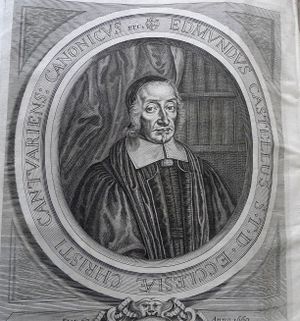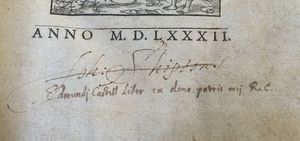Difference between revisions of "Edmund Castell 1606-1686"
m (update link for Canterbury Cathedral provenance, and Sion College inscription.) |
(ownership inscription) |
||
| Line 12: | Line 12: | ||
Castell was involved in an attempt to purchase, for [[organisations::University of Cambridge|Cambridge University]], the important collection of several hundred [[subject::orientalism|oriental]] [[format::manuscript|manuscripts]] assembled by [[associates::Jacob Golius]], [[occupation::professor]] of Arabic at [[organisations::Leiden University|Leiden]] 1624-[[date of death::1667|67]]; this did not come to fruition. The portrait of Castell, prefixed to his [[book title::''Lexicon'']], shows him standing against a set of curtained bookshelves, presumably representing his study. | Castell was involved in an attempt to purchase, for [[organisations::University of Cambridge|Cambridge University]], the important collection of several hundred [[subject::orientalism|oriental]] [[format::manuscript|manuscripts]] assembled by [[associates::Jacob Golius]], [[occupation::professor]] of Arabic at [[organisations::Leiden University|Leiden]] 1624-[[date of death::1667|67]]; this did not come to fruition. The portrait of Castell, prefixed to his [[book title::''Lexicon'']], shows him standing against a set of curtained bookshelves, presumably representing his study. | ||
| + | |||
| + | [[file:Edmund-Castell_Sion-College.jpg|thumb|Ownership inscription from Sion College collections at Lambeth Palace Library]] | ||
| + | ====Characteristic markings==== | ||
| + | Inscription recording a gift from his father Robert Castell. | ||
====Sources==== | ====Sources==== | ||
Latest revision as of 03:10, 27 March 2022
Edmund CASTELL 1606-1686
Biographical Note
Born at East Hatley, Cambridgeshire, son of Robert Castell, a local landowner. BA Emmanuel College, Cambridge 1625, MA 1628, BD 1635, DD 1660. Vicar of Hatfield Peverel, Essex 1635-38, and probably held other livings between then and 1647, when he became rector of Woodham Walter, Essex. Expertise in Arabic and other oriental languages led to his recruitment in 1653 by Brian Walton as an assistant in the project to produce the polyglot Bible which was printed 1654-57. Its success inspired a plan to go on to create a polyglot lexicon of oriental languages. Castell became the main organizer and editor, and spent much time and money during the succeeding decade bringing it to fruition. It was financially ruinous and when published in 1669 (Lexicon heptaglotton), failed to sell; much of the print run remained unsold by the time of Castell’s death. He was appointed professor of Arabic at Cambridge, and made a canon of Canterbury, in 1667, and elected Fellow of the Royal Society in 1674, but spent most of the last decade or so of his life at Higham Gobion, Bedfordshire, where he had been rector since 1663. Many of his inherited assets were sold during the 1660s to cover the costs of the Lexicon and his later years were ones of straitened resources.
Books
Castell gave detailed directions in his will for the disposal of his books and manuscripts, and “all my trunks and boxes wherein any of my books writings or manuscripts are”. All his Hebrew, Syriac, Samaritan, Ethiopic, Persian and Arabic manuscripts were given to Cambridge University Library; all his printed Hebrew books were given to Emmanuel College; and all his Bibles, including oriental versions, were given to Henry Compton, Bishop of London (there is a separate list of the books to be given to Compton in BL Add MS 22905, fo.99). The books given to Cambridge UL and Emmanuel were to be inscribed to mark the gift. His common law books were given to his grandson Edmund Harris, and his divinity books at Higham Gobion (except the Bibles for Compton) were given to his grandson William Harris. A few specified English books (Raleigh, Heylyn and Culpeper) were given to female relatives. The remaining stock of the Lexicon (ca. 600 copies) was also distributed among hisrelatives in parcels of 100 copies apiece.
The extent to which these bequests were carried out is unclear. Compton (q.v.) received some Bibles, which he subsequently gave to Sion College. There are ca.10 books in Emmanuel with Castell’s inscription, although some accounts suggest that more were originally received. None of the manuscripts intended for Cambridge UL were ever taken in and it seems likely that these were returned to Castell’s executors to help to pay the debts of his estate. It seems likely that the bequests to family members may have been wholly or partly dealt with in the same way, as books in divinity and law were included in the sale of the bulk of Castell’s library, which was held by auction in Cambridge by Edward Millington on 30 June 1686. The sale catalogue includes 1051 lots, divided between Latin theology (279), Oriental books (147), lexicographical books (covering Hebrew, Chaldee, Arabic, Latin and Greek, 75), medicine (100), law (21), miscellaneous Latin books (including history, philology, geography, 205), French, Italian and Spanish books (179) and English books (145). Millington’s annotated copy of the catalogue contains a detailed breakdown of the expenses involved in organizing the sale, buyers’ names, and sale prices; the purchasers were a mixture of London booksellers and Cambridge University members, including many undergraduates as well as college fellows. 80% of the medical books remained unsold. Examples: Cambridge UL H*.12.47, Emmanuel, Cambridge, Wimpole Hall, A de Guevara, Lettere, 1575.
Castell was involved in an attempt to purchase, for Cambridge University, the important collection of several hundred oriental manuscripts assembled by Jacob Golius, professor of Arabic at Leiden 1624-67; this did not come to fruition. The portrait of Castell, prefixed to his Lexicon, shows him standing against a set of curtained bookshelves, presumably representing his study.
Characteristic markings
Inscription recording a gift from his father Robert Castell.
Sources
- Birrell, T. ‘Books and Buyers’ in R. Myers et al. (eds.), Under the Hammer: Book Auctions Since the Seventeenth Century, 2001.
- Mandelbrote, G. ‘The Organisation of Book Auctions’ in R. Myers et al. (eds.), Under the Hammer: Book Auctions Since the Seventeenth Century, 2001.
- Oates, J. Cambridge University Library: a History, vol. 1, 1986.
- Pearce, E. Sion, College and Library, 1913, 264–5.
- Stubbings, F. Forty-nine Lives, Cambridge, 1983.
- Toomer, G. J. ‘Castell, Edmund (bap. 1606, d. 1686), Orientalist and Lexicographer’. Oxford Dictionary of National Biography.
- Edmund Castell at Canterbury Cathedral Library.
- Provenance inscription at Sion College collection (Lambeth Palace Library A15.0/B46(2)).

